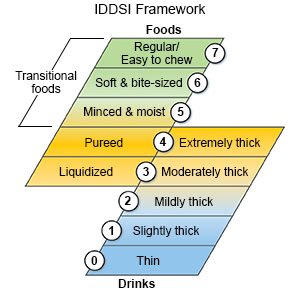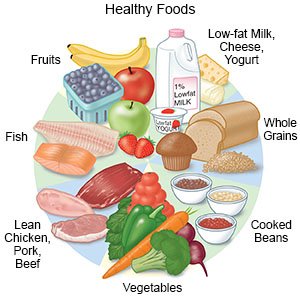Iddsi (International Dysphagia Diet Standardization Initiative)
Medically reviewed by Drugs.com. Last updated on Aug 4, 2025.
What is the International Dysphagia Diet Standardization Initiative (IDDSI)?
The IDDSI is a way to describe and test how thick foods and liquids are. IDDSI contains 8 levels, from the thinnest liquids and foods to the thickest. Your healthcare provider will tell you how thick your food and liquid should be. This depends on how well you can swallow.
What do I need to know about IDDSI levels?
Your healthcare provider will give you a list of foods and liquids to include or avoid. This is based on your IDDSI level. You will be shown how to test liquids and thin foods by pouring them through a syringe. You will also be shown how to use a fork or spoon to test thick liquids and foods. The following is an overview of the IDDSI levels:
- Level 0 is for thin liquids, such as water, milk, juice, coffee, tea, and soft drinks. For babies, level 0 liquids are expressed breast milk or formula. Thin liquids should flow through the syringe in 10 seconds. No liquid should be left in the syringe.
- Level 1 is for slightly thick liquids. This level is mainly used for babies. Level 1 liquids are thicker than water but still flow through a bottle's nipple. A little more effort is needed to drink these liquids. About 1 to 4 mL of the liquid should be left in the syringe after it flows through for 10 seconds.
- Level 2 is for mildly thick liquids. These liquids have the same thickness as nectar, vegetable juice, or a milkshake. It should take some effort to drink the liquid through a straw. About 4 to 8 mL of the liquid should be left in the syringe after it flows through for 10 seconds.
- Level 3 is for moderately thick liquids and liquidized foods. It should be difficult to drink through a straw. About 8 mL should be left in the syringe after it flows through for 10 seconds.
- Level 4 is for extremely thick liquids and pureed foods. The thickness is similar to pudding. The liquid should not separate from the food. These liquids and foods need to be eaten with a spoon. You should not be able to drink them through a straw. A sample should not drip or flow through a syringe in 10 seconds.
- Level 5 is for minced and moist foods. You need to have some chewing ability to eat these foods. These foods should not flow or drip through the syringe after 10 seconds.
- Level 6 is for soft and bite-sized foods. These foods should not flow or drip through the syringe after 10 seconds.
- Level 7 is for regular foods. This level has a separate category for foods that are easy to chew.
 |
How do I test the thickness of a food or liquid?
The following are general guidelines for the types of tests you can use:
- The flow test is used to test how fast liquids and some foods in levels 0 to 3 flow. Use a 10 milliliter (mL) syringe. The syringe will have mL markings on the side. Your healthcare provider can tell you where to get syringes.
- Be ready to mark 10 seconds. Stand where you can see a clock with a second hand, or set a stopwatch to 10 seconds.
- Turn the syringe so the tip is facing down. Put your finger over the tip of the syringe to keep the food or liquid from running out.
- Pour a sample of the food or liquid into the syringe. Watch the clock or start the stopwatch and move your finger off the tip of the syringe.
- At 10 seconds, put your finger back on the tip. Look at the mL markings on the side of the syringe. This will show you how much food or liquid is still in the syringe.
- If no food or liquid flows through, it is too thick for the syringe test. Use a fork or spoon instead.
- The fork drip test is for foods and liquids in levels 3 and 4. Scoop a sample of the food or liquid. If the sample drips through the fork slowly, it is level 3. If only a small amount drips through, it is level 4. If nothing drips through, it is too thick for the fork drip test. Use the spoon test instead. You can use chopsticks or your fingers if you do not have a fork or spoon.
- The spoon tilt test is for foods in levels 4 and 5. Scoop a sample of the food into the spoon. Then tilt the spoon down. The food should stay together and slide off in 1 lump. You might need to shake or flick the spoon gently to get the food to come off.
- The fork pressure test is used to test if foods in levels 4 through 7 are soft, firm, or hard. Put a sample of the food on a dish.
- For level 4, you should be able to make clear marks on the food.
- For level 5, food should easily squeeze through and between the prongs of the fork. You should also be able to mash the food without applying much pressure.
- For level 6, use the side of the fork. You should be able to break a sample into small pieces. You should also be able to mash it easily with the back of the fork. Push on the fork with your thumb hard enough to make your thumbnail turn white. When you lift the fork, the food should still be mashed.
How do I prepare foods or liquids?
Your healthcare provider will give you instructions for preparing your foods and liquids. The following are general guidelines:
- Liquids can be thickened with flour, cornstarch, or potato flakes. You can also use thickeners made for this purpose. Foods that are liquid at room temperature can also be thickened. These include frozen malts, yogurt, milk shakes, eggnog, ice cream, and gelatin.
- Blenderized foods are prepared in a blender or food processor. Cut the food into small pieces first. Mix equal amounts of solid food and liquid, such as milk, fruit juice, or vegetable juice. The liquid should not have chunks or pulp. If you are blending fruits or vegetables, you can use less liquid. Pour the blended food through a strainer to remove chunks, seeds, and fiber. This will help prevent choking. Store blenderized foods in the refrigerator for up to 48 hours. You may instead place them in the freezer.
- Soft foods may be chopped, ground, mashed, or pureed. Cut food into ½ inch or smaller pieces. This makes them easier to swallow. Use chicken broth, beef broth, gravy, or sauces to cook or moisten meats and vegetables. Cook vegetables until they are soft enough to be mashed with a fork. Use a food processor to grind or puree foods to make them easier to chew and swallow. Use fruit juice to blend fruit. Strain soups that have pieces of meat or vegetables that are larger than ½ inch.
- Pureed foods can be made with a blender or food processor. First remove peels, seeds, or other hard parts. You can make food softer by cooking it until soft. Put the food in the blender or processor. Add small amounts of gravy, sauce, vegetable or fruit juice, milk, or half and half. Use only a small amount of liquid at first. Puree the food and add water as needed to get the same texture as pudding. The food should be smooth and have no lumps. Potato flakes can be used to thicken your food if you thinned it too much. Add dry milk powder for extra protein and calories, if needed. Pureed foods can be frozen in small portions and reheated later.
- Minced foods can be prepared with a blender, food processor, food chopper, grinder, or potato masher. Pieces should be ¼ inch (0.635 cm) or smaller. Add gravy, sauce, vegetable or fruit juice, milk, syrup, or half and half to moisten the food. Allow the food to soften and dissolve. Add dry milk powder to foods for extra protein and calories, if needed. Cook vegetables so they are tender enough to be mashed with a fork. Prepared foods can be frozen in small portions and reheated later.
- Bite-sized pieces are cut to be smaller than 1 inch (2.54 cm). To moisten foods and add flavor, serve your food with gravies or sauces. Pour sauce or gravy over bread slices or syrup over pancakes. Allow the food to soften. Cook vegetables until they are tender. Prepared foods can be frozen in small portions and reheated later.
What other guidelines should I follow?
- Eat a variety of healthy foods. Eat 6 to 8 small meals each day to get enough calories and nutrients. You may need to take a multivitamin and mineral supplement if you do not get all the nutrients you need. These can be crushed and added to blenderized food, if needed.

- When you reheat foods, do not allow a tough outer crust to form on the food. This can make it hard to swallow. Stir the food a few times as it reheats to prevent a crust from forming.
- Rinse your mouth with water after each meal. This will help to prevent infections and problems with your teeth.
Where can I find more information about the IDDSI?
You can find official information about IDDSI levels and instructions for thickness testing by going to www.IDDSI.org.
When should I call my doctor?
- You cough or choke when you swallow food or liquid.
- You think the foods or liquids on your plan are difficult to swallow.
- You are having new or worsening problems swallowing.
- You have questions or concerns about your condition or care.
Care Agreement
You have the right to help plan your care. Discuss treatment options with your healthcare provider to decide what care you want to receive. You always have the right to refuse treatment. The above information is an educational aid only. It is not intended as medical advice for individual conditions or treatments. Talk to your doctor, nurse or pharmacist before following any medical regimen to see if it is safe and effective for you.© Copyright Merative 2025 Information is for End User's use only and may not be sold, redistributed or otherwise used for commercial purposes.
Further information
Always consult your healthcare provider to ensure the information displayed on this page applies to your personal circumstances.
